Saga of Moving Polliwog
We started Tuesday, September 26, 2000, at mile 224 on the Cumberland
River from Lakewood Marina where she
had been for over 2 years, headed for mile 43. We had a 16' bass boat,
M/V Rawhide,
rafted up on the starboard side with three 2 foot lenghts of 2X6's
lashed to the gaurds. Then we hung old tires on the 2X6's to
push against and towed with 5/8" lines. We were moving a
70,000-80,000 pound, 60 foot boat (pretty
close to the size of a tractor trailer) with a 1978 70 hp junk bass
boat.
Poliwog at Lakewood marina, mile 224 Cumberland
River
After leaving the Marina we headed toward the dam in 10 mph winds about
2:00.
When we got to DuPont light, the winds came around the point and spun
us
around to the left convincing us trying to get in the lock
would be even too crazy for this hairbrained group. Upon further
inspection, we determined
the rudders were canted to the left about 10 degrees.
We headed back to Lakewood Marina where we had a lot of trouble getting
her
secured on the outside of the barges in the winds. It took us
about 45 minutes to get her moored.
Liquid wrench and a 30" pipe wrench did the trick with the old rusted
cable
tiller system and we got the tillers freed up going both ways.
Jacob, a friend of his, Patch the dog and I headed out again on
Friday. We got off on a late start again, about 1:00.
Having movable
rudders made a big difference in our ability to handle her. We had to
get
her up to about 3 mph before the rudders were affective, so the first
few
hundred yards were critical and difficult. Winds were very light
and predicted to stay that way for the next two or three days. We
proceeded
directly to the dam where the lockmaster had the doors open for
us.
We entered at a crawl and got secured in an amazingly short period
without
much hassle, considering I had no visibility to the other side and we
didn't have good communications worked out yet. There was another
25 foot cruiser
in the lock already, which made me very cautious.
After locking down, the fun began again. We were moored on the
port
side of the lock. To start moving, the bass boat had its motor
turned
all the way to the right. The flotilla would then skid and turn
to
the left (because of the asymmetrical thrust) until sufficient speed
was
obtained to get the rudders affective. In order to turn to
starboard
to get away from the lock wall, the stern needed to go to the left
while
we got up enough speed to go straight. Of course, the lock wall
would
no move. So we just kind of skidded down the lock for a hundred
feet.
We were approaching the lock doors and I knew nothing makes a
lockmaster
more angry than touching “his” lock doors. I went astern to get
about
a 60 degree angle off the port wall. This allowed us to get
enough
speed before we ran into the starboard wall of the lock to exit the
lock
in more or less a straight line.
I had lost a lot of sleep worried about making the sharp turn
immediately below the dam in the potentially fast
current. As it turned out, the bend is to the left,
which is the way the rig naturally wanted to turn anyway.
Being
well into the fall and dry for a month, there was very little flow in
the
river. We went around the turn and I could relax for the first
time
in a month it seemed. Off we went down the river with the GPS
indicating about 6.5 mph! We had 48 gallons of gas on board and
were still on
our first tank. That meant we probably would have enough to get
all
the way to Rock Harbor Marina.
The river was low and we were clicking along at a pace that allowed one
to
observe many things that had gone unnoticed at double that speed.
I
discovered the USCG does not place buoys willy nilly. If there
is a buoy, you can pretty well be assured there is thin water on the
other side! In the case of the markers around mile 215 on the
Cumberland, those buoys are keeping you away from rock ledges that are
barely under the
water at normal pool, but visible to me for the first time with the
water
down about 6 inches. I had been pinned up against one of those
buoys
one time passing a down bound barge and didn't know I was less than 5
feet
away from ripping the bottom right out of the boat.
Howard Toole had looked out the Briley Parkway Bridge on his way to
work
as Captain of a Gaylord River Taxi and saw us go by. He hollered
at
us on the radio on our way past, but my radio battery was too low for
us
to talk. He did tell us the commercial traffic would be watching
for
us. As we approached the Sillman Evans Bridge that carries I-40
and
I-65 across the Cumberland, I noted a 6 barge tow coming upstream
under
the bridge. I slowed down to let them get out of the bridge
before
I got there. After a couple of minutes, I saw we were going to
pass
them under bridge unless I stopped. I could only stop by turning
around
and heading upstream. It would have taken a lot of room to do
that,
and I would have likely ended up in front of the tow. It seemed
to
me the better course of action was to speed back up to 4 mph where we
had
good directional control. As we passed the tow, I realized she
was
just treading water waiting for us to pass. As soon as we got by
she
turned up the screws and shot out a 4 foot wake getting going against
the
current.
We were looking for a place to stop for the night as it was getting
close
to sunset. We passed up Mill Creek, which I latter
regretted.
We got just upstream from downtown Nashville at dark. We had to
land
somewhere... anywhere! We choose the inactive asphalt plant
bollards on the
left bank just above River Front Park docks. As we turned around
in
the current, I just didn't have enough maneuverability pushing from the
side
to get secured to the bollard. We had discovered it was important
to
be able to raft and unraft quickly on our previous aborted half day
trip, so we had rigged up some heavy hooks for our towing lines.
We unhooked and I found I could push very well from directly
astern. Unfortunately,
I had zero forward visibility. Jacob ran forward without securing
a
line to raft us together, so when they started yelling for me to slow
down,
there was nothing I could do. The current slowed us down some,
but
we hit the bollard hard enough to bend the gaurd, break a weld and bend
a
life railing about 6 inches. The first full day and our
first accident! Not a great track record so far, but the damage
is not too
bad and will be fixed with about an hour of work with a cutting torch
and
welder.
Nashville warf, early 1900's. NaBriCo barge
in
right foreground
We started rigging an anchor light. An Ingram towboat came by to
see
if we were moored well and to offer assistance. Later he
went to get a sand barge a few
hundred yards upstream. He may have had an ulterior motive to
make
sure we were not a hazard any more! Ha, Ha. Actually, we received
nothing but good words and courtesies from all the towboat Captains and
Pilots we encountered.
I especially am grateful to all the Ingram and Hunter people for taking
such
good care of their neighbors on the Cumberland River. I feel like I
have
been welcomed into a new family where everybody will do anything they
can
to help you if you get into trouble.
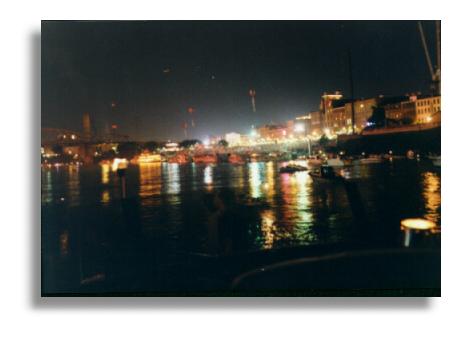 Nashville Warf 7/4/00
Nashville Warf 7/4/00
After running Jacob and his friend to River Front Park, Patch and I
went
back to Polliwog to hold a light for passing boats. When the
River
Taxi went by and I saw the barmaid counting her money, I figured that
was
their last trip and we turned in about midnight. We sleep pretty
well considering Patch’s Border Collie genes made her do a night
watchman's tour
of the boat every half hour or so. I had no blanket, but foul
weather
coats and sweat shirts were just about perfect. At daybreak we
headed
upstream to load the bass boat and retrieve the car. I noted Cumberland
Utility
District dumping raw sewage in the river and made notes to call the
Tennessee
EPA Monday morning. I got home and called Jacob at
10:30. By t 1:00 and headed upstream to fetch Polliwog.
I sweated bullets getting going again Saturday. We had to make
a 180 degree turn in the current, then immediately start turning to the
right.
While mooring to the bollard the previous night we had broken the cable
that
turns the rudders to port, so we could only turn them to the
right.
The good news was that was the way they needed to be turned to offset
the
asymmetrical thrust of the bass boat. The bad thing was we need
all
the control we could get to get past a million dollars worth of
cruisers
up for Sunday's Titans game. To make matters worse, the winds
were 5-10
out of the Northeast and blowing us right toward those boats.
Luckily
we got up enough speed quickly enough to make it under the Shelby
Street
bridge and get past the downtown docks. Next worry was the
downtown
railroad bridge built in the 1800's. By the time we got to it, I
had
gotten over to the right bank and some protection from the wind.
We
took an angle across the gap in the narrow railroad bridge which became
our
standard procedure for narrow bridges.
We were making about 4.5 mph on Saturday and discovered our fuel tanks
were
lasting 1 hour 45 minutes as opposed to the 50 minutes the day before.
We
were using about half the power and getting about 20% better fuel
milage,
a little over .9 miles per gallon.
I didn't know exactly when Id be able to move Polliwog again, so we
made
the decision to put her in Richland Creek for a few days.
When
we were approaching Richland Creek, Hunter had a tow working right at
the
mouth. We slowed to current speed, which turned out to be about
1.6 mph at that point on the river. The towboat finished and we
felt more
comfortable heading into the creek. With Jacob calling out the
directions
and distances on the blind port side of the boat, we ended up going
right
into the creek with no trouble and tied up to a couple of trees.
The weather turned ugly and windy so we ended up leaving her there for
two
weeks.
After I got some tax returns done on October 16th, the weather window
for
the upcoming week looked good again and we made plans to head out on
the
17th. We got our normal late start and it took us nearly 3 hours
to
get the 47' cruiser rafted up. With the bass boar, Rawhide on
starboard, and the cruiser, Future, on Port, we pulled out of the creek
with no fuss
and headed downstream at about 6 mph. Forty eight miles behind us
and
135 to go.
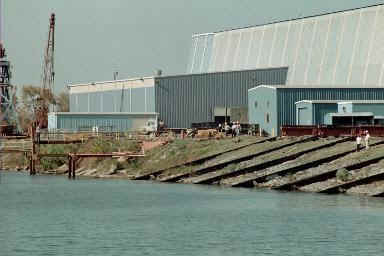
We called Nashville Bridge Company to let them know we were
coming by. They called the shop and they let all their employees
out
to the river to watch us go by. We felt pretty special.
We got to Cheatam dam about 15 minutes too late to get locked through
before
a double lock tow came up. So, we sat for 3 hours and watched the
sun
go down over the lake. We were tied up to the mooring bits right
at the “Arrival Point” sign (not legal we were told the next day),
although
we could have declared an emergency maybe having been trapped by
darkness.
We were actually required to keep a watch all night and dogs don't
count,
even dogs that bark at other boats when they get too close.
Luckily
fog had stopped all the tows on the river.
The next morning I started to change the oil on Future's starboard
engine
and found the pump would not pump the oil. A man stopped by to
look
at Polliwog. He owned a bait shop/repair yard and said he’d
go
get his pump. Before he got back I had my pump working and had
started changing the oil. However, there I was getting help from
a fellow mariner
who offered anything he had to help and didn’t know a stranger.
He
closed the bait shop so his Wife could come see the boat. The fog
lifted
about 8:00 AM and we locked through. The lockmaster gave us a
couple copies of the rules books with particular rules highlighted she
wanted
us to not violate anymore. Thanks for the information and
diplomacy.
110 miles to go.
The area immediately below the dam is pretty narrow of course and not
very
pretty with its high sandy banks. About 2 miles below the dam,
the
dingy davit on Polliwog that was holding Future’s stern and pulling
lines
came loose. Oh my, we were floating down the river sideways, in a
narrow
chanel, praying a tow was not nearby It took us about an
hour to get everything secured and going again. 107 miles to go.
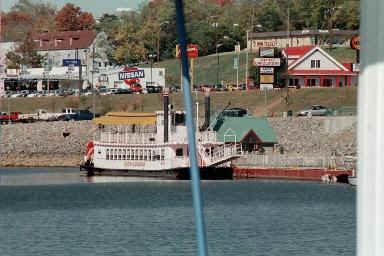 We got to Clarksville about noon and Cumberland City about dark.
A
friend, LP, called as she was driving down the Interstate to ask if we
could
see the beautiful sunset. We were headed about 280 degrees and I
was in awe. We decided we had to keep going. We found we
could make
a little over 5 mph with just Future, and about 7.5 with both boats
pushing.
We talked to the pilot of a Hunter Marine boat, M/V JW Hunter for quite
some time about 10:00. He had much experience taking barges in
and out of
the marina where we were going. He said he didn’t like going in
there
at all. It is open on the NW side and can be terrible in windy
situations.
Indeed, there is a sunken barge in mud on the SW side of the
entrance.
The left hand side is bordered by an old railroad track that is barely
covered
under normal pool. Just something to loose sleep over
another
night. I was beginning to question my sanity, as others had been
questioning
it all along. During the passing with the JW Hunter, I ended up
sideswiping
a buoy with Rawhide. Dale Kelley is right, they don’t do much
damage,
but they do make a loud thump when they hit.
We got to Clarksville about noon and Cumberland City about dark.
A
friend, LP, called as she was driving down the Interstate to ask if we
could
see the beautiful sunset. We were headed about 280 degrees and I
was in awe. We decided we had to keep going. We found we
could make
a little over 5 mph with just Future, and about 7.5 with both boats
pushing.
We talked to the pilot of a Hunter Marine boat, M/V JW Hunter for quite
some time about 10:00. He had much experience taking barges in
and out of
the marina where we were going. He said he didn’t like going in
there
at all. It is open on the NW side and can be terrible in windy
situations.
Indeed, there is a sunken barge in mud on the SW side of the
entrance.
The left hand side is bordered by an old railroad track that is barely
covered
under normal pool. Just something to loose sleep over
another
night. I was beginning to question my sanity, as others had been
questioning
it all along. During the passing with the JW Hunter, I ended up
sideswiping
a buoy with Rawhide. Dale Kelley is right, they don’t do much
damage,
but they do make a loud thump when they hit.
We had great control with both boats. I had rigged up a
come-along on
the tiller arms in order to kick the rudders to port to compensate for
the
thrust of Future on the port side. We pressed on in the dark
knowing
the fog would roll in and pin us till it lifted in the morning.
About
that time Jacob’s FRS radio bounced overboard. We decided without
the
radios, we’d shut off Rawhide for the night and get everybody safely
onboard
Future. Jacob started piloting and quickly ran over a green
can.
It went all the way under Rawhide and banged on the motor.
About
11:00 I felt like the fog was getting worrisome and we needed a place
to
land for the night. We tried a cove at Tobbaccoport, but it
looked
too narrow and shallow, so we went on. At Linton light we found a
first
class landing. We would be in a narrow place on the river, but
visible from both directions and in a legal place to sit out the
fog. Just
to be sure, we notified Mr. Nelson at the nearest lock (Cheatam) via
telephone.
We got in bed at 12:25 with 45 miles to go. What we didn’t know
until
the next day was this was just about the last semi protected place for
us
to tie up. Even a blind pig can find a acorn! It took us
about
an hour to get moored. I'm beginning to think like a towboat - no
maneuver
can be done in less than an hour. Although Jacob and I were
getting
communications worked out and we were starting to anticipate each
other's
moves - heck, Father and Son working as a team! That was worth
the
price of admission by itself.
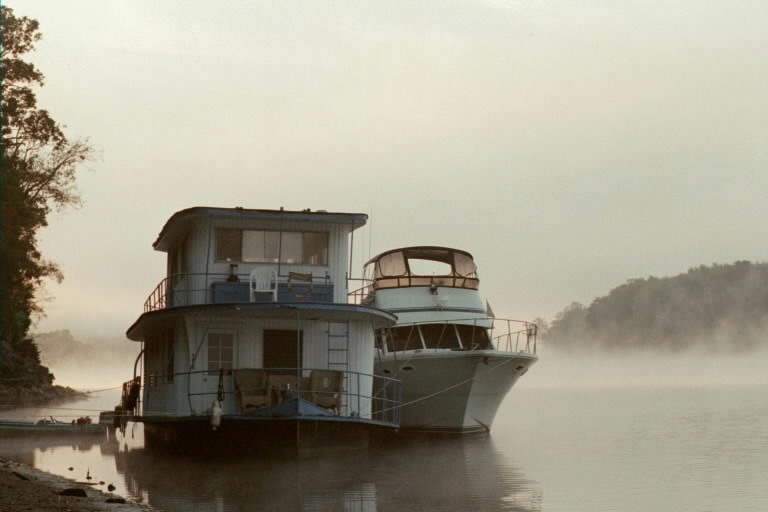 At 5:26 a towboat making about one mph in the fog woke me up as he went
by.
I got out of bed shortly after that and discovered Polliwog's starboard
side
was on the mud and about six inches high. I got everyone up and
we
proceeded to extricate Polliwog from the mud. The bass boat
couldn’t
do it by itself, so we had to unraft Future. We rigged two bow
lines
evenly and with both motors astern we pulled her off without too much
fuss.
However, now we were drifting in a very narrow channel without any
maneuvering
ability while we got rafted back up. This whole operation took us
about
and hour and a half. Off we took past the Nature Preserve as the
fog
was lifting. What perfect timing! There were thousands of
birds in the wetlands of the nature preserve. We passed a flock
of about
30 Pelicans.
At 5:26 a towboat making about one mph in the fog woke me up as he went
by.
I got out of bed shortly after that and discovered Polliwog's starboard
side
was on the mud and about six inches high. I got everyone up and
we
proceeded to extricate Polliwog from the mud. The bass boat
couldn’t
do it by itself, so we had to unraft Future. We rigged two bow
lines
evenly and with both motors astern we pulled her off without too much
fuss.
However, now we were drifting in a very narrow channel without any
maneuvering
ability while we got rafted back up. This whole operation took us
about
and hour and a half. Off we took past the Nature Preserve as the
fog
was lifting. What perfect timing! There were thousands of
birds in the wetlands of the nature preserve. We passed a flock
of about
30 Pelicans.
We made a couple of telephone contacts with LP. Les Hardy
was
bringing her down to Rottgering Marina, along with Shay Freeman to help
me
get Future home. We planned on getting there about noon. As
we
went past Prizer Point Marina we sent Jacob in to get a can or two of
gasoline.
He knew nothing about side channel markers and ran aground in about a
foot
of water at 20 mph. I cruised on down while he got off the boat
and
started pushing. Another
hour lost to a seemingly simple operation that was supposed give us
some
additional margin of safety. The next call to LP was to tell her
were
would be there about 1:30. 15 miles to go.
It was very tempting to cut some of the bends in the river.
However, our recent groundings in conjunction with the low water
convinced me I really
didn’t want to risk it. I had never actually been able to get a
reading
off a gauge anywhere, so I didn’t know exactly how low the lake was.
When
we got to the marina I sent Jacob in to check it out. He came
back
knowing where the markers were and where to go, so maybe his earlier
grounding
was just God’s way of preparing him for this more important scouting
trip.
The lake was low enough to make the old train track bed visible on the
port
side made a very graphic picture how numerous boats had been torn
up on them.
The winds were light and we had no trouble getting in, although not
without some anxiety.
We got Polliwog secured, the paperwork filled out, and LP
and Shay loaded back up for the return trip. It was 3:30
Friday afternoon with135 miles to get back home. We
had a Ladies at the Helm party scheduled for 10:00 the next
morning. I
wish I could adequately describe the look and sounds from my crew when
they
figured out how long it would take to do 130 miles with 10.5
miles
an hour across the bottom showing on the GPS. We stopped at
Prizer point
to get some fuel. I thought we had enough to get back home as we
had run 20 hours since filling up and I just wanted to be
safe.
Much to my chagrin, I ran hard aground just as Jacob had,
although I was following the markers! It turned out that a buoy
was missing. Much to my surprise, we only
had 20 gallons of fuel left! I guess we’d been running Future at
a
much, much higher throttle setting than I thought since we burned 17
gallons
an hour as opposed to our normal 11.
Shortly after getting back on the River they had the stereo cranked up
to
120 decibels and the beer cans popping. That’s about the time we
missed
a little bend in the river and ran across a mud bar going over 10
mph.
Luckily our momentum carried us nearly all the way across it. I
said,
“Well Ladies, we need to get serious about this trip. Turn down
the
stereo so we can communicate and go to work. We have less than an hour
before dark for
you to learn everything you ever dreamed of knowing about river
navigation!”
They settled down and learned how to read a chart. They learned how to
use
the binoculars to look at markers. They learned how to judge the
angle
of bends in the river. They learned to repeat the names of all
the landmarks
we went by so we could all help each other keep track of where we
were.
They learned all the symbols used by the maps. And most
importantly,
they learned how to move the searchlight and find the next buoys.
It
was wonderful to have 2 pairs of young eyes which could pick up the
reflections from the cans and nuns about 300 yards farther than I
could. We had
gotten aground once with Rawhide, once while moored and now twice with
Future.
We had been extremely lucky and did absolutely no damage in any of
those
groundings in soft mud. However, we couldn’t afford any more
mistakes.
I set the depth meter at 9 feet, the guaranteed channel minimum depth
and
it only went off twice more the rest of the trip when we were at the
edge
of the channel and the water was a little thin. 110 miles to go.
We got to Cumberland City about 9:00 Friday night. LP had made us
a
salad and some cordon blue stuff. She had dinner ready just as we
pulled
into the bright lights around the TVA fleeting area at the steam
plant.
We slowed to about half speed speed and ate dinner in the bright
lights.
What perfect timing! Now if the fog will just hold off...
LP
and Shay had contingency plans for in the morning just in case.
We
could have the party meet us down the river, we could reschedule, we
could
“just do, do, do it!” 75 miles to go, we’re almost half way
there.
The fog didn’t seem to be getting much worse. Visibility with the
search
light was about a quarter mile. The river was narrow enough that
we
could follow the bank if we couldn’t pick up marks. There is a
long
stretch South of Clarksville where the marks are few and far
between.
It was stressful following the banks with only one light because it is
hard
to tell if the river was turning or the boat had changed
directions.
It was nice to get up to the lights of Clarksville where it was light
enough
to see the outline of the river banks. We got to Clarksville at
12:13AM.
Hey! About 50 miles to go and the fog seems to be holding off.
We overtook an Ingram barge just North of Clarksville. He was
nice to
give us room and illuminate the points for us as we went
by.
I just can’t say enough good things about the Ingram Pilots! We
got
in the habit of radioing our position at lights and day marks, bridges
and towns, as were the tows. Someday I’m going to have a
well-tuned
high output antenna like they have on the towboats. 40 miles to
go.
Passed a barge heading downbound and warned him about the tow 5
miles
or so behind us.
By the time we got to Cheatam dam the fog was about as bad as I could
stand.
It was 2:30 Saturday morning and I had been on duty for 21 hours.
Luckily, the river was narrow below the dam so following the shore was
pretty easy.
We had not run aground again after we got serious. I had only gotten
crossed
up a couple of times and quickly recovered after slowing down and
studying
the map. LP and Shay had been taking turns navigating and
sleeping.
They had both figured navigation out and were doing a great job.
As we pulled up behind the short river wall at the dam to get out of
the
way of the water being dumped, LP hollered, “Did you see that
lightning?”
“No,” I lied. By the time she was throwing the lines around the
floating
bits in the lock, the sky opened up. What a trooper! LP was
soaked
by the time we got secured and moving up. Luckily the rain was
warmer
than the air. 25 miles to go! And I’m very familiar with 20
of
those miles. Uh oh, the rain brought in the fog! We were in the
wide
part of the river just above the dam and lost sight of the shore.
We
slowed to idle speed and crept back to port and the right descending
bank. We crept along at about 1,100 rpm (1.5 mph) for 30
minutes before the fog
lightened up enough for us to get back to a reasonable speed. 20 miles
to
go.
Just before we got to Ashland City I started nodding out. It was
time
for Shay to take over. I knew the river well and we were picking
up
the shoreline with the lights from Nashville reflecting off the low
rain
clouds. Just before daybreak Lynn came on duty and I finally got
a chance
to lay down for the first time in 25 hours. I got about 15
minutes
of a nap before my back started hurting so much it woke me up. Oh
boy! Commodore Marina - 5 miles to go! The orange leaves
were floating on a glass-smooth river,
daybreak with blue herrons, 58 degrees, it just doesn't get in better
than
that.
We tied up at Rock Harbor Marina and I got in bed at 7:00 after walking
a
very excited Patch. Again, those Border Collie genes were telling
her
she was glad to be on familiar ground. The next thing I knew LP
was
knocking on the stateroom door telling me the Ladies were here and it
was
time to go back on duty. Well, that was a good three hours of
sleep!
We headed up the river on our tour of Historic Nashville. No one
on
the boat was aware how important the river was to our heritage.
We
saw Demonbreun’s cave (the first Non-Indian to see the Cumberland) and
everyone
got a chance to drive.
While one of the ladies was learning how to drive, she abruptly pulled
one
or both of the throttles back. I was sitting facing backward on a
bulkhead
on the cruiser. I fell over backwards off the little
bulkhead
and headed butt first down an open hatch (where a ladder USED to be)
toward
the kitchen floor, 7.5' away. Luckily, I grabbed the open
hatch
cover on my way past and arrested my fall. The person who
best saw the trick had her hand out
to help me and I asked her to take my coffee cup, which I still had my
the
other hand. I was on the way to breaking my neck and I was still
trying to keep from spilling the coffee! Mother would be
proud. She asked if I was hurt and I said "no, but could you
please
see if I'm bleeding on the back of my head." I wasn't, so it just
went
down in the book of "Stupid Bob Tricks." Isn't that the
epitome?
We did 260 miles of very a dangerous activity, then I nearly killed
myself
relaxing after the trip.
My back is sore from bending over to work the searchlight. I know
I
want searchlight controls where they can be operated from a standing
helm
position without bending over, and I want two! My feet hurt from
standing up for
a significant portion of the 35 hours I was piloting. I want a
tall
helm chair that I can move anywhere I need to move it. Forget
those
short seats bolted to the floor.
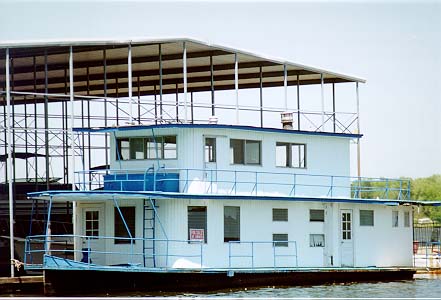

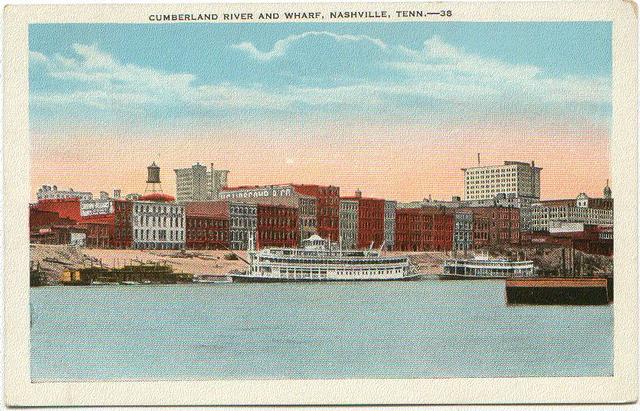


 We got to Clarksville about noon and Cumberland City about dark.
A
friend, LP, called as she was driving down the Interstate to ask if we
could
see the beautiful sunset. We were headed about 280 degrees and I
was in awe. We decided we had to keep going. We found we
could make
a little over 5 mph with just Future, and about 7.5 with both boats
pushing.
We talked to the pilot of a Hunter Marine boat, M/V JW Hunter for quite
some time about 10:00. He had much experience taking barges in
and out of
the marina where we were going. He said he didn’t like going in
there
at all. It is open on the NW side and can be terrible in windy
situations.
Indeed, there is a sunken barge in mud on the SW side of the
entrance.
The left hand side is bordered by an old railroad track that is barely
covered
under normal pool. Just something to loose sleep over
another
night. I was beginning to question my sanity, as others had been
questioning
it all along. During the passing with the JW Hunter, I ended up
sideswiping
a buoy with Rawhide. Dale Kelley is right, they don’t do much
damage,
but they do make a loud thump when they hit.
We got to Clarksville about noon and Cumberland City about dark.
A
friend, LP, called as she was driving down the Interstate to ask if we
could
see the beautiful sunset. We were headed about 280 degrees and I
was in awe. We decided we had to keep going. We found we
could make
a little over 5 mph with just Future, and about 7.5 with both boats
pushing.
We talked to the pilot of a Hunter Marine boat, M/V JW Hunter for quite
some time about 10:00. He had much experience taking barges in
and out of
the marina where we were going. He said he didn’t like going in
there
at all. It is open on the NW side and can be terrible in windy
situations.
Indeed, there is a sunken barge in mud on the SW side of the
entrance.
The left hand side is bordered by an old railroad track that is barely
covered
under normal pool. Just something to loose sleep over
another
night. I was beginning to question my sanity, as others had been
questioning
it all along. During the passing with the JW Hunter, I ended up
sideswiping
a buoy with Rawhide. Dale Kelley is right, they don’t do much
damage,
but they do make a loud thump when they hit.  At 5:26 a towboat making about one mph in the fog woke me up as he went
by.
I got out of bed shortly after that and discovered Polliwog's starboard
side
was on the mud and about six inches high. I got everyone up and
we
proceeded to extricate Polliwog from the mud. The bass boat
couldn’t
do it by itself, so we had to unraft Future. We rigged two bow
lines
evenly and with both motors astern we pulled her off without too much
fuss.
However, now we were drifting in a very narrow channel without any
maneuvering
ability while we got rafted back up. This whole operation took us
about
and hour and a half. Off we took past the Nature Preserve as the
fog
was lifting. What perfect timing! There were thousands of
birds in the wetlands of the nature preserve. We passed a flock
of about
30 Pelicans.
At 5:26 a towboat making about one mph in the fog woke me up as he went
by.
I got out of bed shortly after that and discovered Polliwog's starboard
side
was on the mud and about six inches high. I got everyone up and
we
proceeded to extricate Polliwog from the mud. The bass boat
couldn’t
do it by itself, so we had to unraft Future. We rigged two bow
lines
evenly and with both motors astern we pulled her off without too much
fuss.
However, now we were drifting in a very narrow channel without any
maneuvering
ability while we got rafted back up. This whole operation took us
about
and hour and a half. Off we took past the Nature Preserve as the
fog
was lifting. What perfect timing! There were thousands of
birds in the wetlands of the nature preserve. We passed a flock
of about
30 Pelicans.